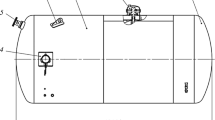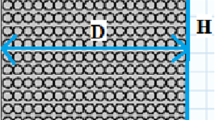Abstract
Carbon dioxide (CO2) based natural circulation loops (NCLs) has gained attention due to its compactness with higher heat transfer rate. In the present study, experimental investigations have been carried out to capture the transient behaviour of a CO2 based NCL operating under subcritical as well as supercritical conditions. Water is used as the external fluid in cold and hot heat exchangers. Results are obtained for various inlet temperatures (323–353 K) of water in the hot heat exchanger and a fixed inlet temperature (305 K) of cooling water in the cold heat exchanger. Effect of loop operating pressure (50–90 bar) on system performance is also investigated. Effect of loop tilt in two different planes (XY and YZ) is also studied in terms of transient as well as steady state behaviour of the loop. Results show that the time required to attain steady state decreases as operating pressure of the loop increases. It is also observed that the change in temperature of loop fluid (CO2) across hot or cold heat exchanger decreases as operating pressure increases.











Similar content being viewed by others
Abbreviations
- c p :
-
specific heat capacity(J/kgK)
- Cu:
-
Copper
- D :
-
internal diameter of inner pipe or loop diameter (m)
- d o :
-
external diameter of inner pipe or loop diameter (m)
- g :
-
gravitational acceleration (m/s2)
- H 0 :
-
total height of vertical pipe (m)
- L :
-
length of CHX (sink) and HHX (source) (m)
- L 0 :
-
total length of a horizontal pipe (m)
- L 1 :
-
adiabatic pipe length on horizontal pipe (m)
- m :
-
mass flow rate (kg/s)
- Q :
-
heat transfer rate (W)
- \(q^{{{\prime \prime }}}\) :
-
heat flux (W/m2)
- R :
-
Radius of curvature for bends (m)
- SS:
-
Stainless steel
- T :
-
temperature (K)
- t :
-
time (s)
- ∆T :
-
loop fluid temperature difference between riser and downcomer centres (K)
- ∆T w :
-
temperature rise/drop of water across the CHX or HHX (K)
- CHX :
-
cold heat exchanger, sink
- CO 2 :
-
carbon dioxide
- HHX :
-
hot heat exchanger, source
- w :
-
water
References
Pearson A (2005) Carbon dioxide—new uses for old refrigerant. Int J Refrig 28:1140–1148
Kumar KK, Ramgopal M (2009) Carbon dioxide as secondary fluid in natural circulation loops. Proc IMechE, Part E: J Process Mech Eng 223:189–194
Yadav AK, Ramgopal M, Bhattacharyya S (2012) CO2 based natural circulation loops: new correlations for friction and heat transfer. Int J Heat Mass Transf 55:4621–4630
Dostal V, Hejzlar P, Driscoll MJ (2006) The supercritical carbon dioxide power cycle: comparison to other advanced power cycles. Nucl Technol 154:283–301
Bondioli P, Mariani C, Mossa E, Fedelli A, Muller A (1992) Lampante olive oil refining with supercritical carbon dioxide. J Am Oil Chem Soc 69:477–480
Fourie FCVN, Schwarz CE, Knoetze JH (2008) Phase equilibria of alcohols in supercritical fluids Part I. The effect of the position of the hydroxyl group for linear C8 alcohols in supercritical carbon dioxide. J Supercrit Fluids 47:161–167
Yamaguchi H, Zhang XR, Fujima K (2008) Basic study on new cryogenic refrigeration using CO2 solid–gas two phase flow. Int J Refrig 31:404–410
Ochsner K (2008) Carbon dioxide heat pipe in conjunction with a ground source heat pump (GSHP). Appl Therm Eng 28:2077–2082
Kim DE, Kim MH, Cha JE, Kim SO (2008) Numerical investigation on thermal–hydraulic performance of new printed circuit heat exchanger model. Nucl Eng Des 238:3269–3276
Kreitlow DB, Reistad GM (1978) Themosyphon models for down hole heat exchanger application in shallow geothermal systems. J Heat Transf 100:713–719
Torrance KE (1979) Open-loop thermosyphons with geological application. J Heat Transf 100:677–683
Chen L, Zhang X (2014) Experimental analysis on a novel solar collector system achieved by supercritical CO2 natural convection. Energy Convers Manag 77:173–182
Yanagisawa Y, Fukuta M, Ogura N, Kaneo H, Operating characteristics of natural circulating CO2 secondary loop refrigeration system working with NH3 primary loop. In: Proceedings of the 6th IIR-Gustav Lorentzen Natural Working Fluids Conference, 2004
Kiran Kumar K, Ramgopal M (2011) Experimental studies on CO2 based single and two-phase natural circulation loops. Appl Therm Eng 31:3437–3443
Chen L, Deng BL, Zhang XR (2013) Experimental investigation of CO2 thermosyphon flow and heat transfer in the supercritical region. Int J Heat Mass Transf 64:202–211
Sharma M, Vijayan PK, Pilkhwal DS, Asako Y (2013) Steady state and stability characteristics of natural circulation loops operating with carbon dioxide at supercritical pressures for open and closed loop boundary conditions. Nucl Eng Des 265:737–754
Liu G, Huang Y, Wang J, Lv F, Leung LHK (2016) Experiments on the basic behavior of supercritical CO2 natural circulation. Nucl Eng Des 300:376–383
Liu G, Huang Y, Wang J, Leung LHK (2016) Heat transfer of supercritical carbon dioxide flowing in a rectangular circulation loop. Appl Therm Eng 98:39–48
Archana V, Vaidya AM, Vijayan PK (2015) Flow transients in supercritical CO2 natural circulation loop. Proc Eng 127:1189–1196
Swapnalee BT, Vijayan PK, Sharma M, Pilkhwal DS (2012) Steady state flow and static instability of supercritical natural circulation loops. Nucl Eng Des 245:99–112
Kiran Kumar K, Ramgopal M (2009) Steady-state analysis of CO2 based natural circulation loops with end heat exchangers. Appl Therm Eng 29:1893–1903
Yadav AK, Ramgopal M, Bhattacharyya S (2014) Transient analysis of subcritical/supercritical carbon dioxide based natural circulation loops with end heat exchangers: numerical studies. Int J Heat Mass Transf 79:24–33
Yadav AK, Ramgopal M, Bhattacharyya S (2016) Effect of tilt angle on subcritical/supercritical carbon dioxide based natural circulation loop with isothermal source and sink. ASME J Therm Sci Eng Appl 8:011007-1–011007-8
Sabersky RH, Hauptmann EG (1967) Forced convection heat transfer to carbon dioxide near the critical point. Int J Heat Mass Transf 10:1499–1508
Yadav AK, Bhattacharyya S, Ramgopal M (2016) Optimum operating conditions for subcritical/supercritical fluid based natural circulation loops. ASME J Heat Transf 138:112501-1–112501-9
He S, Kim WS, Jackson JD (2008) A computational study of convective heat transfer to carbon dioxide at a pressure just above the critical value. Appl Therm Eng 28:1662–1675
Yadav AK, Ramgopal M, Bhattacharyya S (2012) CFD analysis of a CO2 based natural circulation loop with end heat exchangers. Appl Therm Eng 36:288–295
Acknowledgment
The study has been carried out under a project sponsored by Extramural Research Division, Council of Scientific and Industrial Research (CSIR), Government of India. The financial support provided by CSIR is gratefully acknowledged.
Author information
Authors and Affiliations
Corresponding author
Ethics declarations
Conflict of interest
On behalf of all authors, the corresponding author states that there is no conflict of interest.
Rights and permissions
About this article
Cite this article
Yadav, A.K., Ramgopal, M. & Bhattacharyya, S. Transient analysis of subcritical/supercritical carbon dioxide based natural circulation loop with end heat exchangers: experimental study. Heat Mass Transfer 53, 2951–2960 (2017). https://doi.org/10.1007/s00231-017-2038-z
Received:
Accepted:
Published:
Issue Date:
DOI: https://doi.org/10.1007/s00231-017-2038-z




